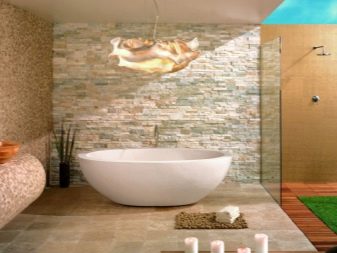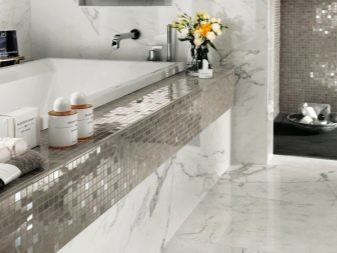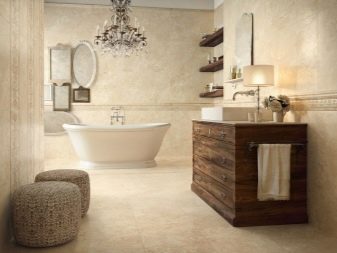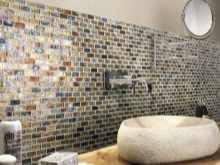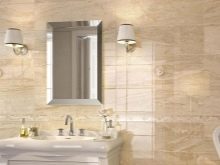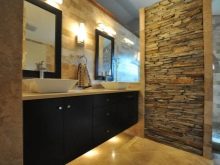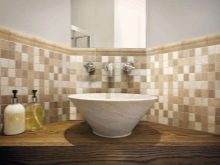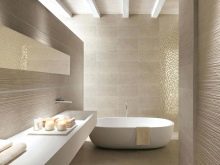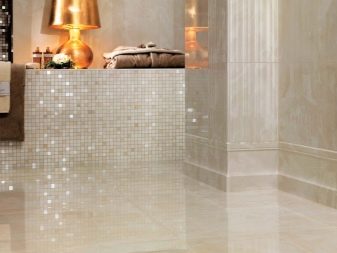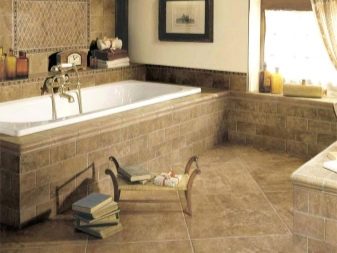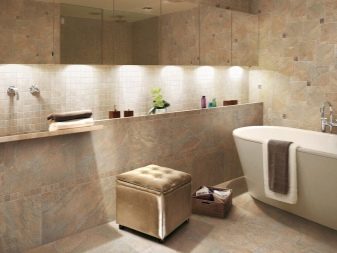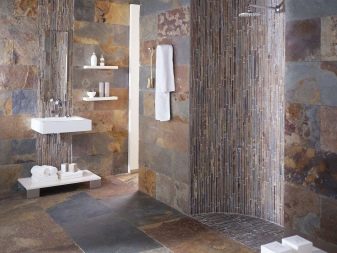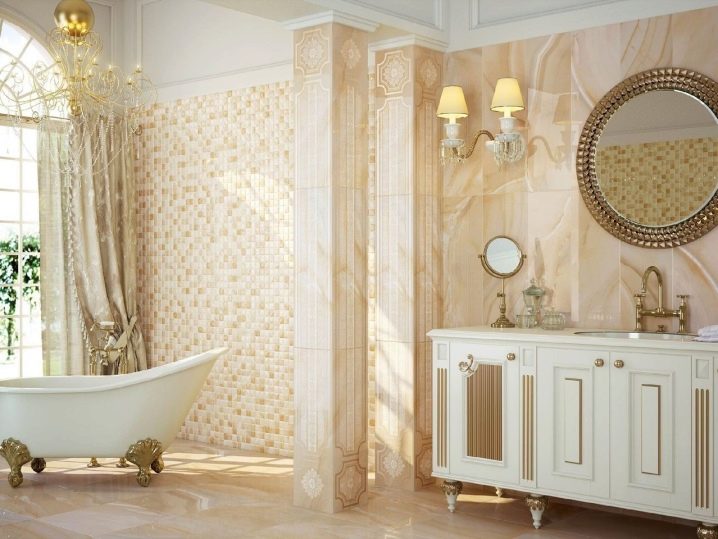Stone tile for bathroom: features of choice
A bathroom in an apartment or house is one of the most important premises necessary for a person’s life. Its feature is a wet microclimate. Therefore, finishing materials that must be chosen for such a room must withstand large amounts of water.
Special features
Natural stone in the decoration of a residential building or apartment looks beautiful as an expensive and presentable material. It does not wear out for a long time, it looks beautiful, in the interior design gives a sense of reliability of the home. But natural material has natural pores and a certain composition.
Under the influence of excess moisture and modern household detergents, it can begin to dim and collapse. Its operation in the bathroom has its own difficulties.When finishing stone premises, where almost all the time there is a high level of humidity, it needs special care, which can cause certain inconveniences for the owners. In addition, sawn natural stone has a lot of weight and complexity when laying. This is an expensive material that is not affordable for the average consumer.
The tile which is used for finishing of rooms, possesses much better operational properties, than a natural stone. It burns at high temperature and practically does not absorb water, is inert to household detergents, it can be of various colors and textures. It is lighter in weight, which is important when finishing the walls, is ideal in shape, easily assembled into a canvas and much cheaper than natural rocks. If you want to have natural materials in the bathroom, you can replace them with tiles that imitate stone. Thus, the bath will look like a finished natural material, but the care of surfaces, their operation will be much easier than in the case of natural materials.
Imitation of a stone in a tile
One of the most popular stones in the decoration of rooms is marble.Delicate shades, beautiful texture allow you to create a refined interior and combine this finishing material with any other. But marble is a very fragile stone. It easily wears out, collapses under the influence of acids, therefore at its use for them careful care is necessary. But manufacturers from different countries have created many tile collections that include imitation in marble.
A tile imitating this natural material can be of such varieties as:
- imitation of white marble with oblique lines of texture;
- imitation of gray marble with vertical lines of texture;
- imitation of marble, resembling reddish sandstone with a variety of texture of the lines;
- imitation of marble of any shades. At the same time, the tile retains the beauty of the texture of the stone, but the colors can be of a wide variety - pink, lilac, and any other that are not found in the natural environment.
Manufacturers of tile successfully make imitation and other stones. As a rule, tile under the stone can be divided into large groups. These are tiles with a rough relief surface, a rough surface and a smooth shiny one. Each of them has its own advantages.excellent performance and beauty.
The rough surface of the tile shows an image of a medieval castle or manor. A smoother, but rough tile can be used for the floor, as spray water may occasionally appear in the bathroom below. If the floor tile is polished, the person will slip, fall and may be seriously injured in the room. The smooth brilliant tile with imitation of stone patterns perfectly fits into any interior, it is combined with ornamental compositions, picturesque panels, a small mosaic. In a bathroom of any style, a part of its surfaces can be tiled under stone. This will give her beauty and a certain highlight.
The stones that imitate most in a tile are onyx, granite and crystalline formations. There is a tile with patterns in the form of malachite. Onyx imitation is performed in gray and black shades with angular patterns. Imitation of granite can be in different colors according to the diversity of this rock. It has a complex texture.
A crystal is a tile surface that refracts color. Such a surface does not recreate a certain rock, it imitates crystalline formations as a whole, but only in a more properly ordered form. And also there are many fantasy options that do not reflect a certain type of natural stone. In such a tile, an irregular texture is combined, which manifests itself in a cut of stone with a variety of shades. Thus, the designer's imagination allows decorating the bathroom not only with tiles in the form of one of the stone rocks, but also with any fantasies on the subject of mining construction and finishing materials.
Kinds
If you want to make repairs with the surfaces, trimmed under the stone, you need to look at different types of tiles. Each species has its own characteristics. Today quite popular ceramic matte tiles. The brick tile happens glazed and not glazed. Porcelain tile has a special strength and practically does not absorb moisture. It is perfect for wet rooms, such as a bath.
Majolica is a painted tile. Among its diversity you can find the most beautiful samples of marbled painting.And also recently tiles with a 3D effect have appeared, which, when looking at them, create the impression of the depth of a tile. This tile looks very attractive and much richer than normal. There is a variant of imitation of a wild stone, if the stone can be injured, the torn surface of the tile will never cause cuts to a person.
Finishing material with an imitation of a stone in the bathroom should not only be beautiful, but also be suitable for its operation in a humid environment. There are types of tiles that do not tolerate such a microclimate and are suitable only for dry rooms. This is a plaster tile, so you should not use it in the bathroom. She can quickly come into disrepair. Be sure when choosing a finishing material for the bathroom should take into account the effect of moisture.
On the features of the choice of tiles under the stone for the bathroom, see the following video.


